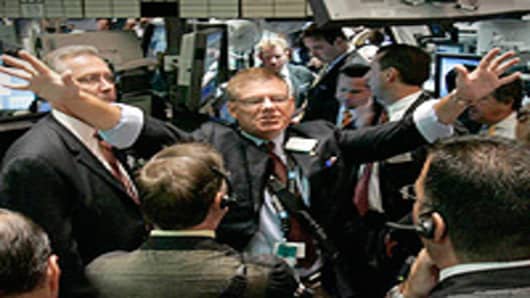April has been called the “cruelest month,” but in the past two years, it’s when the stock market made its highs for the year.
So investors start the second quarter with that on their minds, and head into a holiday shortened week, where the most important piece of data will be released when the stock market is closed.
The March jobs report is released Good Friday, when just the bond marketand some electronic futures markets are open for trading in the U.S.
Besides the monthly jobs report, there is a steady stream of important data all week long that will paint a fresh picture of the manufacturing environment and the consumer.
The important headlines will be March auto sales, chain store sales, the ISM manufacturing survey, weekly jobless claims, plus the contents of minutes of the Fed’s last meeting.
The Dow finished the past week at 13,211.96, up 1 percent for the week and closing the first quarter with a 8.14 percent gain, its best first quarter since 1998. The S&P 500 was at 1,408.45, for the week and up 12 percent for the quarter.
The sharp rise in the stock market since October has had analysts predicting a pullbackas stock indices hit each new level, and they are still expecting to see that as the second quarter begins.
“We’ll get a pullback but I don’t think we’ll get anything disastrous,” said Citigroup chief equities strategist Tobias Levkovich. He said he expects to see a five to seven percent reversal. “Maybe it’s the pause that refreshes, barring some exogenous event,” he said.
He expects to see a selloff in “the next few months. I think it’s hard to pin point.” Levkovich said the market decline should not be like the 22 percent the S&P lost last year from late April through early October.
At that time, the global economy was dealing with a sudden oil price rise, after the Arab spring; the Japanese earth quake and tsunami aftermath, and the tightening of financial conditions from the European debt crisis.
Barclays Capital U.S. equity portfolio strategist Barry Knapp said the recent weaker-than-expected data could be a signal. Six of the last seven pieces of housing data were shy of expectations.
“The markets are running a little bit ahead of reality right now," said Knapp. "It just means they're vulnerable."
Some analysts say the market could follow its seasonal history, and investors could “sell in May,” as they did last year. They also are watching gasolineto see if the steep price rise stings consumers and starts to become a setback for the economy.
“Where is the pullback? I’m still waiting. I just think the longer it takes, maybe the more painful it will feel but I still think it will be pretty shallow,” said J.P. Morgan chief U.S. equities strategist Thomas Lee.
As for next week, he said the bias could start out positive. “Usually the first day (of the quarter) does have inflows. I don’t really have any expectations except that seasonally speaking, markets are going to have a positive bias through May. I still think you’re going to have a pretty good tone to the market. I think the concerns about China, quarterly earnings and interest rates—they don’t really occur until the summer,” said Lee.
“Seasonals have played a big role. They’ve been increasingly important, and maybe because the fundamental trends haven’t been so prevalent,” he said. “…A correction definitely seems way overdue, but it’s really keeping everyone at home waiting for this thing.”
Analysts expect to see investors buy the dips, as many are still underinvested in U.S. equities and have lost out on recent gains.
Econorama
The March jobs report is the big event for markets in the coming week.
“I think we’ll get a couple hundred thousand jobs in March. I say that with some trepidation because there will be some pay back from the warm winter weather at some point,” said Mark Zandi, chief economist at Moody’s Economy.com. “The question is when, and it could be March, but my sense is it’s going to be April and May, so underlying job growth...is 200,000.”
February’s jobs report showed job growth of 227,000 and an unemployment rate of 8.3 percent.
“I think investors are realizing we’re not in the new world of 250,000 jobs per month, at least not yet,” Zandi said.
Zandi said he is also watching auto sales closely. “That’s been one bright shiny part of the economy in recent months. It got up over 15 million units in February. I suspect we’ll get a little bit of a pullback, but how much will be important in terms of peoples’ thinking about consumer spending more broadly. If we’re 14 million or south of that, it will be very disappointing,” he said.
The Fed minutes, released Tuesday afternoon, could give some clues as to further Fed easing. The Fed’s “operation twist,” which involves selling short-dated Treasury securities and buying longer dated, expires in June.
“The market seems to be convinced that there’s going to be some additional or extension to twist, and I’m sure the minutes will address that in some capacity,” said Deutsche Bank chief U.S. economist Joseph LaVorgna.
What to Watch (All times are ET)
Monday
1000 am ISM manufacturing
1000 am Construction spending
1000 am St. Louis Fed Pres. Bullard speaks
1235 pm Cleveland Fed Pres. Pianalto speaks
Tuesday
Monthly auto sales
1000 am Factory orders
0200 pm FOMC minutes
1605 pm San Francisco Fed Pres. Williams speaks
Wednesday
0815 am ADP employment
1000 am ISM nonmanufacturing
1100 am San Francisco Fed Pres. Williams speaks
ThursdayMonthly chain store sales
0830 am Initial claims
0910 am St. Louis Fed Pres. Bullard speaks
Friday
Stock market closed—Bond and some futures market shortened session
0830 am Employment report (March)
0300 pm Consumer credit
Follow Patti Domm on Twitter: @pattidomm
Questions? Comments? Email us at marketinsider@cnbc.com




